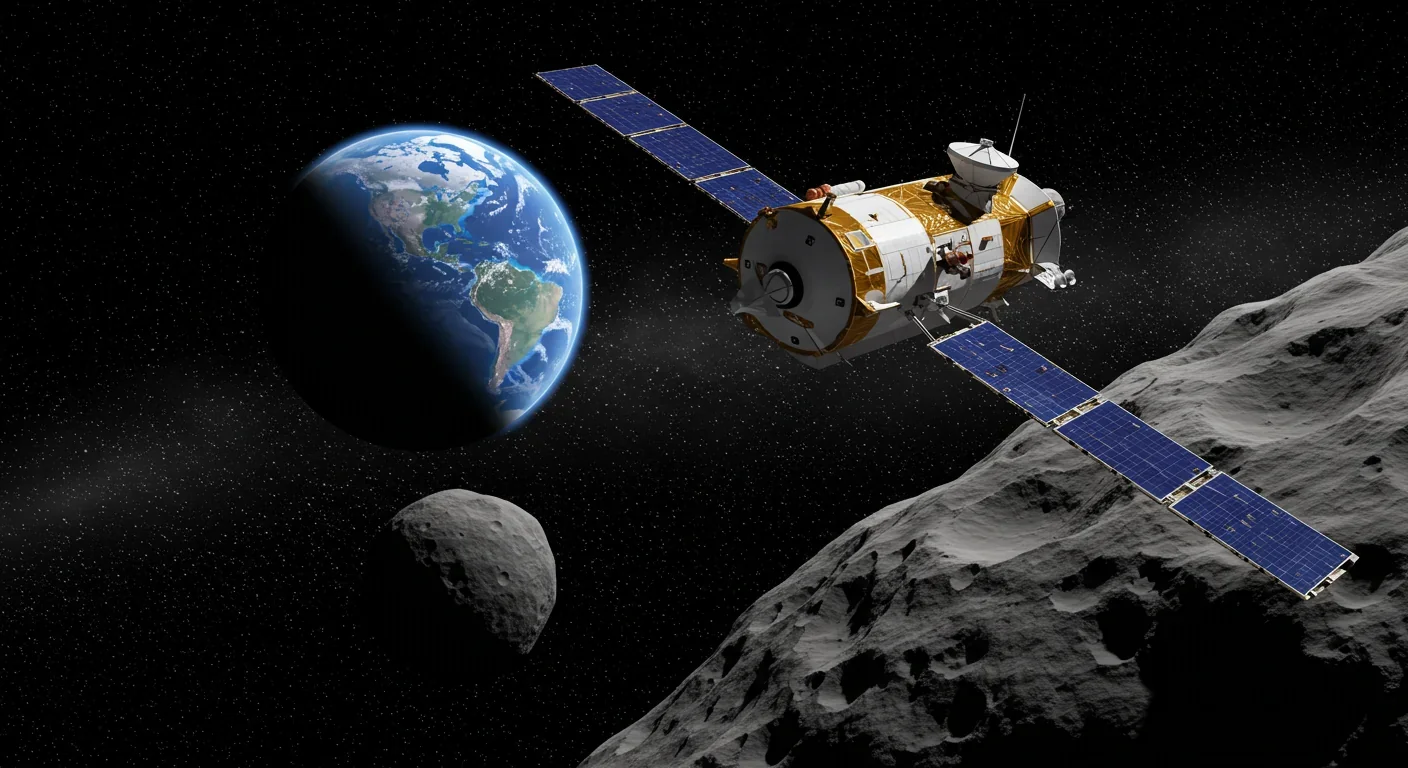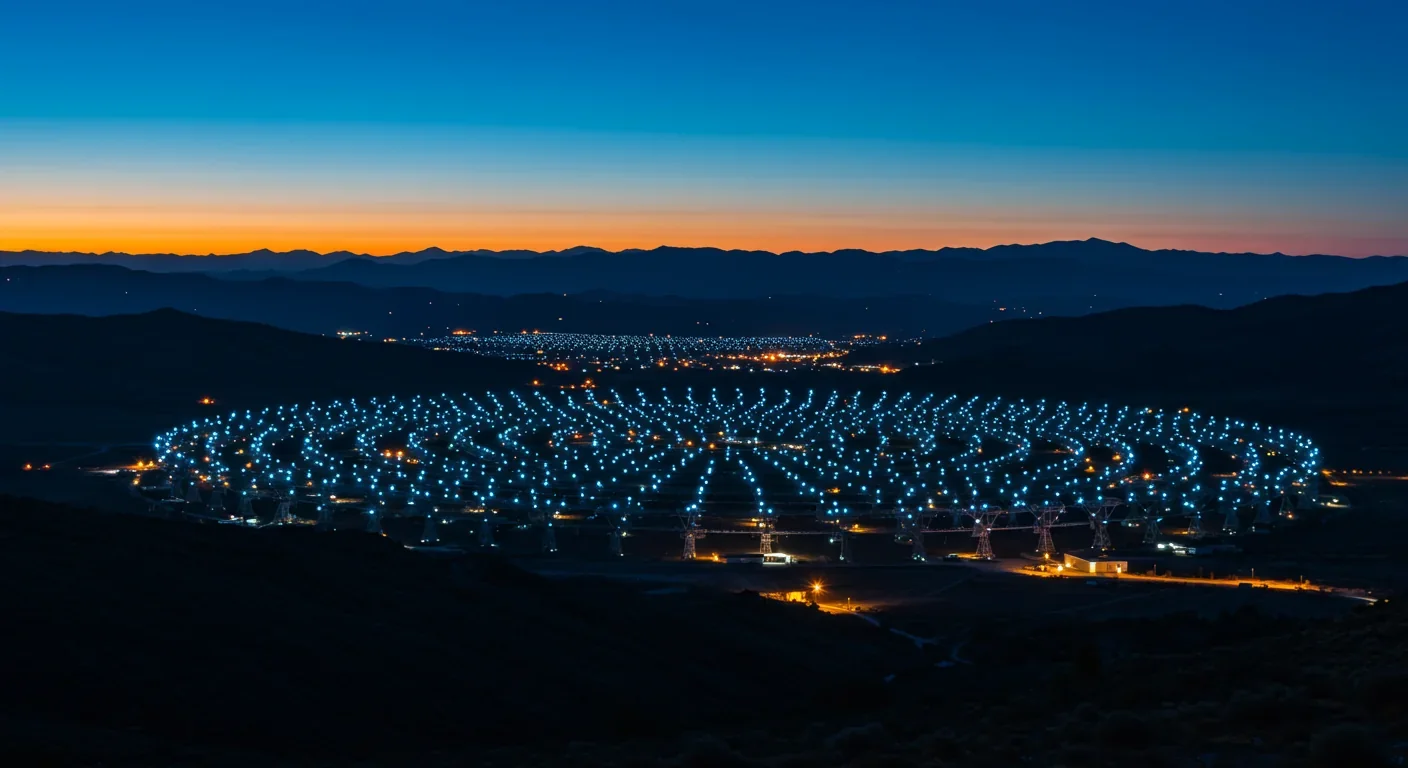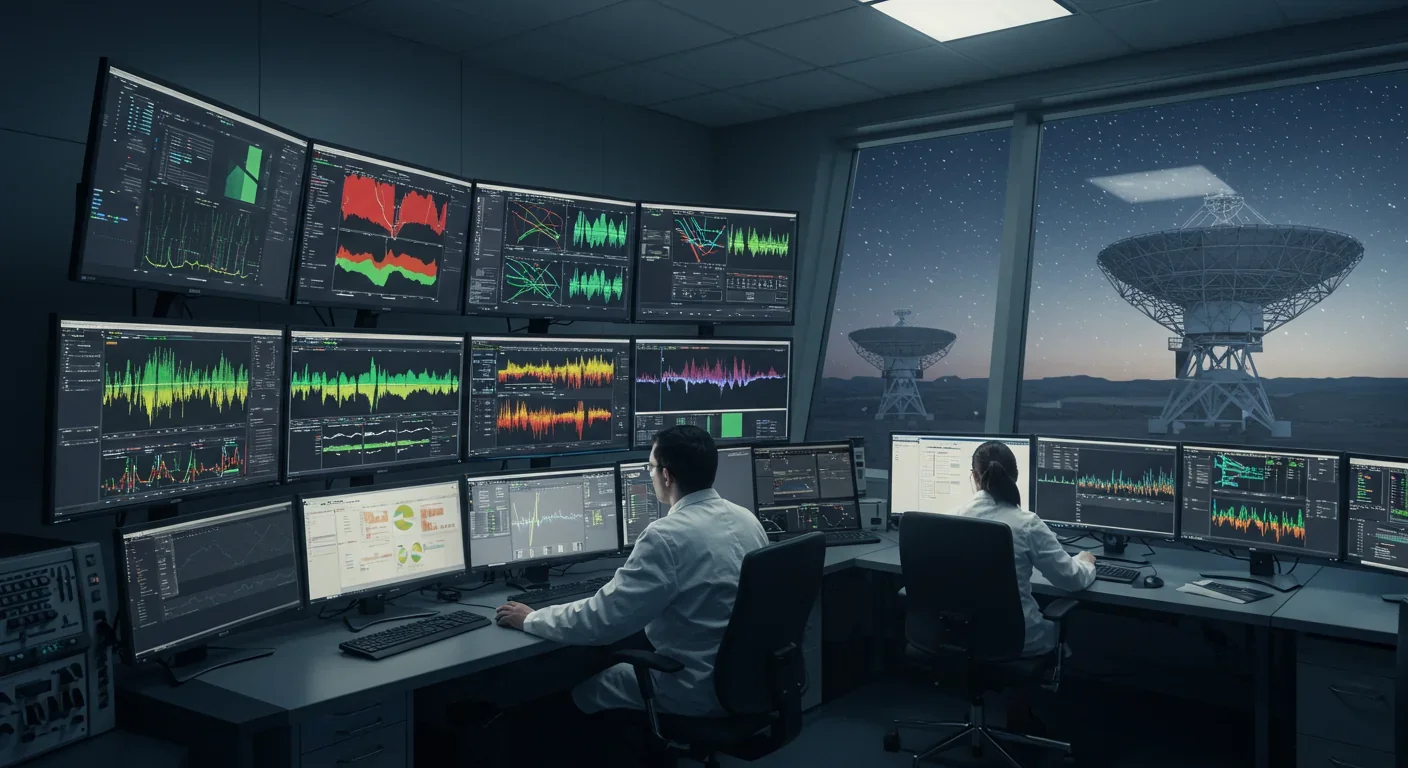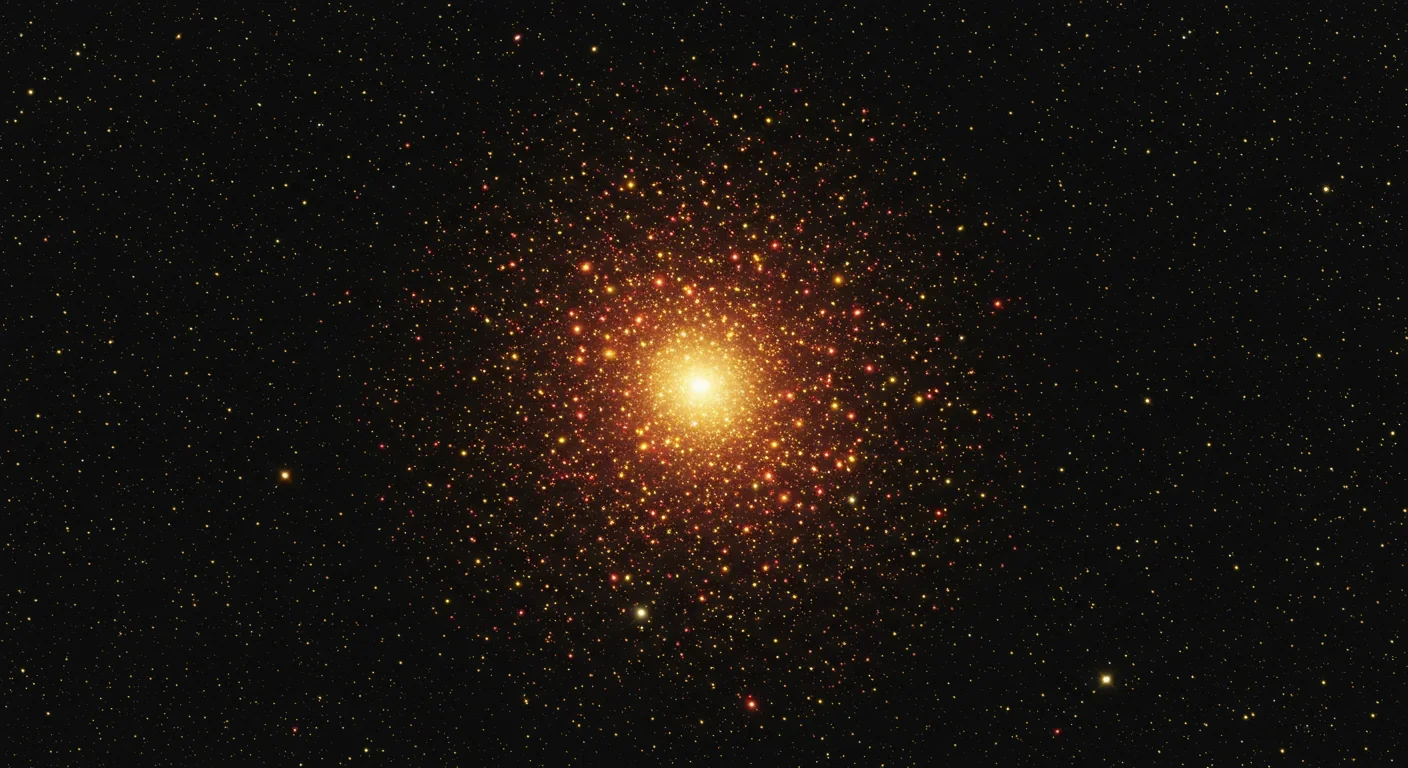AI Spacecraft Navigate Asteroids Autonomously in Deep Space

TL;DR: Fast Radio Bursts—millisecond flashes from distant galaxies releasing more energy than the Sun in days—have evolved from cosmic oddities into powerful tools. Advanced telescopes like CHIME now detect dozens weekly, tracing origins to specific galaxies and even individual stars. Magnetars, ultra-magnetized neutron stars, are confirmed sources, yet mysteries abound: repeaters in dead galaxies, second-scale periodicities, and absence of X-ray counterparts. FRBs now map invisible baryons, measure cosmic expansion with 1% precision, and probe fundamental physics. The next decade promises thousands of detections daily via SKA, revolutionizing cosmology and perhaps uncovering phenomena stranger than we imagine.

In 2007, astronomer Duncan Lorimer was sifting through archival pulsar data when he stumbled onto something impossible. Buried in six-year-old observations from Australia's Parkes telescope was a radio flash lasting just five milliseconds—yet it released more energy than the Sun produces in an entire month. The signal originated not from our galaxy, but from three billion light-years away. Lorimer had accidentally discovered the first Fast Radio Burst, a cosmic phenomenon so intense, so brief, and so mysterious that it would spark an entirely new field of astronomy.
Today, nearly two decades later, FRBs have evolved from astronomical curiosities into powerful tools reshaping our understanding of the universe. Advanced telescopes like CHIME in Canada and the Australian Square Kilometre Array Pathfinder now detect dozens of these cosmic whispers every week, pinpointing their origins to specific galaxies billions of light-years distant. And in a stunning breakthrough announced in early 2025, scientists combined the James Webb Space Telescope's infrared vision with radio arrays to trace one FRB—the brightest ever recorded—to a single star 130 million light-years away, narrowing its birthplace to a cosmic neighborhood just 45 light-years across.
Fast Radio Bursts defy easy explanation precisely because they compress such extraordinary energy into such fleeting timescales. The average FRB releases as much energy in a millisecond as the Sun emits in three days. Their radio signatures show massive dispersion—lower frequencies arrive slightly after higher ones—indicating the signals have traversed vast expanses of ionized gas, confirming extragalactic distances measured in billions of light-years.
That dispersion, quantified by the dispersion measure (DM), becomes a cosmic tape measure. The DM equals the total column density of free electrons integrated along the line of sight; as radio waves pass through the warm-hot intergalactic medium, each electron delays the pulse proportionally to the inverse square of its frequency. By comparing pulses across a wide bandwidth—say, from 400 to 800 MHz—astronomers calculate how much ionized material the burst traversed, translating that into an approximate cosmological distance.
But distance is only the first puzzle. The brevity of FRBs implies the emission region must be compact, likely no larger than a few hundred kilometers. Only neutron stars—the collapsed cores of dead massive stars—pack enough energy density into such small volumes to explain the observations. Among neutron stars, magnetars stand out: these ultra-magnetized remnants wield surface magnetic fields exceeding 10¹⁴ Gauss, a trillion times stronger than Earth's field and capable of warping spacetime itself.
In April 2020, the magnetar SGR 1935+2154 in our own Milky Way produced a bright radio burst—FRB 200428—detected simultaneously in radio by CHIME and STARE2 and in X-rays by satellites including INTEGRAL and Insight-HXMT. That coincident detection, the first FRB pinned to a known source, proved beyond doubt that magnetars can generate FRB-like events. The fluence exceeded 1.5 megajansky-milliseconds, a brightness that, if scaled to cosmological distances, matches extragalactic FRBs perfectly.
Yet even with magnetars confirmed as one source, the emission mechanism remains contested. Leading models include coherent curvature radiation from charged particles streaming along twisted magnetic field lines, magnetic reconnection at the magnetar's light cylinder releasing bursts of energy, and monster shocks—powerful shock waves triggered when a magnetar's crust fractures, launching a fast magnetosonic pulse that steepens into a relativistic shock capable of maser-like radio emission at gigahertz frequencies. Recent simulations show that such shocks dissipate energy through chaotic particle dynamics rather than collective plasma interactions, generating radio bursts with properties matching observed FRBs.
The explosion in FRB detections owes everything to radical telescope designs. CHIME, the Canadian Hydrogen Intensity Mapping Experiment, exemplifies this innovation. Rather than a traditional dish that points and tracks, CHIME consists of four massive cylindrical reflectors—each 20 meters wide and 100 meters long—lying stationary on the ground in British Columbia. Over a thousand dual-polarization antennas feed signals into a 13-terabit-per-second digital correlator comprising 256 GPU nodes.
This architecture performs digital beamforming in real time, synthesizing hundreds of simultaneous beams across the sky without any moving parts. CHIME continuously monitors a vast swath of sky in the 400–800 MHz band, detecting FRBs at a rate of dozens per day. In its first year alone, CHIME cataloged 536 FRBs; by 2024, that tally exceeded 5,000. The system achieves sub-second latency, broadcasting public alerts—formatted as Virtual Observatory Events (VOEvents)—within 13 seconds of detection, enabling rapid multi-wavelength follow-up by X-ray satellites, optical telescopes, and gamma-ray observatories worldwide.

To boost localization precision, CHIME recently added three outrigger arrays located hundreds of kilometers away in British Columbia. By cross-correlating signals from CHIME and the outriggers—a technique called Very Long Baseline Interferometry (VLBI)—astronomers achieve milliarcsecond positional accuracy, a twentyfold improvement over CHIME alone. Calvin Leung of McGill University likens the precision to "spotting a quarter from 100 kilometers away." That leap allowed the team to trace FRB 20240209A to its host galaxy and subsequently identify a likely globular cluster origin.
Meanwhile, in the Southern Hemisphere, Australia's ASKAP employs phased-array feeds on each of its 36 twelve-meter dishes, creating up to nine dual-polarization beams per antenna and yielding a combined field of view of 30 square degrees. ASKAP's Commensal Real-time ASKAP Fast Transients (CRAFT) survey streams data to the Pawsey Supercomputing Centre, where custom pipelines identify FRBs within seconds. ASKAP has localized over 70 FRBs to their host galaxies with arcsecond precision, more than doubling the sample of FRBs with known hosts and enabling statistical studies of progenitor environments.
The Deep Synoptic Array (DSA-110) in California, with 110 dishes spread over several kilometers, combines interferometric imaging with a large collecting area, detecting and localizing FRBs at rates comparable to ASKAP. And on the horizon, next-generation instruments promise even greater sensitivity. CHORD, CHIME's planned successor, will incorporate enhanced digital backends and more outriggers, further improving localization and enabling detection of fainter, more distant bursts. The Hydrogen Intensity and Real-time Analysis eXperiment (HIRAX) in South Africa, with 1,024 six-meter dishes, will process 6.5 terabits per second and expects to find tens of FRBs per day across the southern sky.
One of the field's most tantalizing puzzles is the stark division between repeating and apparently one-off FRBs. About 3% of detected FRBs repeat, some prolifically. FRB 20121102A, the first repeater discovered, emitted over 1,600 bursts during a multi-year campaign; FRB 20201124A produced 2,812 bursts in just 49 days of monitoring. Repeaters enable detailed study: astronomers can schedule multi-wavelength observations, measure polarization and spectral evolution, and search for periodicity.
In March 2025, researchers analyzing FRB 20201124A reported the first-ever detection of a second-scale periodicity in a repeating FRB. On two specific days separated by weeks, bursts clustered into narrow phase windows at periods of 1.706 and 1.708 seconds. The derived period derivative implies a surface magnetic field exceeding 10¹⁵ Gauss and a spin-down age of just 44 years—hallmarks of an extremely young magnetar. This discovery provides the most direct evidence yet linking FRB emission to magnetar rotation, moving beyond circumstantial association to concrete dynamical proof.
Other repeaters show longer periodicities. FRB 20180916B exhibits a 16.35-day activity cycle: bursts cluster in a four-day active window followed by 12 days of silence. FRB 20121102A displays a 157-day period. Such regular modulation hints at binary systems, where orbital dynamics or precession modulate the emission geometry. If a magnetar orbits a massive companion star or another compact object, tidal forces, accretion flows, or geometric beaming could switch emission on and off in a predictable rhythm.
Yet most FRBs appear once and vanish. These one-off events could arise from genuinely cataclysmic, non-repeating sources—neutron star mergers, for instance, or magnetar giant flares that destroy their progenitors. Alternatively, all FRBs might repeat, but at rates so low or intervals so long that current survey cadences miss subsequent bursts. Deep radio follow-up of one-off FRB 20250316A, the brightest ever, found no persistent radio source down to stringent limits, ruling out luminous magnetar wind nebulae and favoring either a low-density environment or an older, quieter neutron star.
Statistical studies reveal population differences. High-frequency FRBs (detected above ~1 GHz) and low-frequency FRBs (below ~1 GHz) follow distinct luminosity functions and event-rate densities. High-frequency, high-luminosity bursts are rarer, with a steeper decline in event rate at low redshift, suggesting distinct progenitor channels or emission mechanisms. Frequency, not luminosity, appears the primary discriminator, implying that environmental factors—magnetic field strength, plasma density, or shock dynamics—dictate observable properties more than intrinsic energy budgets.
Beyond solving the mystery of their origins, FRBs have emerged as precision cosmological probes. Their dispersion measures encode the total free-electron column density from source to Earth, partitioned among the host galaxy, the intergalactic medium (IGM), intervening halos, and our Milky Way. By modeling each component, astronomers can isolate the IGM contribution and use it to measure cosmic structure and expansion.
The Macquart relation, verified with localized FRBs, links dispersion measure to redshift: more distant bursts traverse more ionized gas and thus show higher DMs. This relationship enables FRBs to trace the distribution of baryonic matter—ordinary atoms—across cosmic time. Remarkably, only about half of the universe's baryons appear in galaxies and galaxy clusters; the rest reside in the warm-hot intergalactic medium (WHIM), a diffuse plasma at temperatures of 10⁵–10⁷ Kelvin that emits almost no light. Harvard astrophysicist Liam Connor and colleagues used 13 well-localized FRBs to estimate that roughly 76% of all baryons hide in this intergalactic fog, confirming theoretical predictions and solving the longstanding "missing baryon problem."
FRBs also offer a new, independent route to measuring the Hubble constant, H₀, the expansion rate of the universe. By combining observed DMs with host galaxy redshifts and modeling the expected IGM and host contributions using cosmological simulations like IllustrisTNG, researchers derive distance estimates free from the systematic uncertainties plaguing traditional methods like Type Ia supernovae or Cepheid variables. A 2024 study using 108 localized FRBs yielded H₀ = 69.4 ± 2.1 km/s/Mpc, broadly consistent with both the cosmic microwave background (CMB) value and local distance-ladder measurements. With 527 non-localized CHIME FRBs, the precision improved to ±0.68 km/s/Mpc. The authors project that a sample of 500 localized FRBs could constrain H₀ to 1%, potentially resolving the Hubble tension—the troubling 9% discrepancy between early-universe and late-universe H₀ estimates.
Innovative techniques amplify FRB cosmological utility. Self-calibration clustering in dispersion-measure space sidesteps the need for precise host-galaxy DM modeling by leveraging the statistical clustering of FRBs in DM bins. Simulations show that this method, applied to future surveys like the Square Kilometre Array (SKA), can reconstruct FRB redshift distributions with mean biases below 1%, even without optical spectroscopy for every burst. Model-independent approaches using artificial neural networks trained on cosmic chronometers further reduce reliance on assumed cosmological models, yielding a Hubble constant of 70.3 ± 1.8 km/s/Mpc from FRBs alone and a joint constraint—combining FRBs, supernovae, baryon acoustic oscillations, and the CMB—of 69.9 ± 0.7 km/s/Mpc with 1.2% precision. Intriguingly, the same analysis hints at a 2.4-sigma deviation from the standard ΛCDM prediction for the deceleration parameter, suggesting accelerated expansion may deviate from simple models.
The demographics of FRB host galaxies have upended early assumptions. Initially, repeaters like FRB 20121102A localized to dwarf, star-forming galaxies with vigorous stellar nurseries, reinforcing the magnetar-via-core-collapse narrative. Yet recent discoveries shatter that tidy picture.
In early 2024, CHIME and its outriggers localized FRB 20240209A to a massive, quiescent elliptical galaxy at redshift 0.138—a galaxy with a median stellar age of 11.3 billion years, a stellar mass exceeding 10¹¹ solar masses, and a current star-formation rate below 0.36 solar masses per year. The FRB's location lies 130,000 light-years from the galaxy's center, the largest offset known for any FRB, far from any active star-forming region. This is the first repeating FRB found in a quiescent, elliptical host—demographics more typical of short gamma-ray bursts or Type Ia supernovae than young magnetars.
Vishwangi Shah and collaborators considered multiple scenarios: a natal kick ejecting the progenitor from the galactic disk, formation in a low-luminosity satellite galaxy, or origin in a globular cluster. The last scenario emerged as most plausible. Globular clusters are ancient, dense stellar environments where dynamical interactions can produce exotic compact binaries, millisecond pulsars, and potentially magnetars via accretion-induced collapse of white dwarfs or mergers of binary neutron stars. FRB 20200120E, the nearest known extragalactic repeater at 3.6 megaparsecs, resides in a 10-billion-year-old globular cluster in the M81 galaxy group, lending credence to this channel.
Another paradigm shift came from high-redshift detections. In 2024, astronomers localized FRB 20240304B at redshift 2.148, corresponding to a lookback time of about 10 billion years—when the universe was only three billion years old. The host is a low-mass, clumpy, star-forming dwarf with vigorous star formation and low metallicity (10–20% solar). This discovery doubled the redshift reach of localized FRBs and established that FRB progenitors were active during the peak epoch of cosmic star formation, implying short delay times consistent with massive-star origins.

A comprehensive metallicity study of 40 FRB hosts found no clear lower bound on metallicity, contrary to earlier claims that FRBs required metal-poor environments. Host galaxies span a wide metallicity range and are broadly consistent with the star-formation-rate-weighted mass-metallicity relation of the general galaxy population. A marginal 0.05-dex offset below the fundamental metallicity relation may reflect lower-than-average star-formation rates rather than a strict metallicity threshold. This result implies metallicity modulates the relative efficiency of different formation channels—binary stellar mergers in metal-rich galaxies versus isolated core collapse in metal-poor dwarfs—but does not strictly regulate FRB production.
Furthermore, a statistical study of 30 localized FRBs from the DSA-110 survey found that FRBs preferentially occur in massive, star-forming galaxies. Since 84% of massive stars are in binaries, and high metallicity enhances stellar winds and mass transfer, the authors infer that magnetars forming via stellar mergers—common in massive, metal-rich systems—may dominate the FRB population. This scenario elegantly reconciles the metallicity distribution with the observed host masses.
Understanding FRB emission mechanisms requires catching them in the act across the electromagnetic spectrum. Coordinated multi-wavelength campaigns have placed stringent limits on X-ray, optical, and gamma-ray counterparts, shaping theoretical models.
During simultaneous observations of repeating FRB 20190520B with Swift's X-ray Telescope and FAST's radio receiver, ten radio bursts were detected, yet no corresponding X-ray or optical flashes appeared. Upper limits constrained the energy ratio of soft X-rays (0.3–10 keV) to radio emission below 5.7×10⁻⁵, and the optical-to-radio ratio below 5.5×10⁻⁷. These limits disfavor models predicting strong high-energy emission, such as magnetospheric particle acceleration models requiring simultaneous X-ray bursts, and suggest either beaming away from Earth or intrinsically weak high-energy output.
Similarly, a four-year monitoring campaign of FRB 20121102 with the Nançay Radio Telescope and INTEGRAL yielded 11 simultaneous radio and high-energy observations. No X-ray or gamma-ray bursts were detected above a 5-sigma fluence limit of 2.7×10⁻⁷ erg/cm² (25–400 keV), ruling out magnetar giant flares as drivers of at least some repeating FRBs and pointing toward a diversity of progenitor mechanisms.
Yet during SGR 1935+2154's 2022 outburst, a different story emerged. High-cadence NICER and NuSTAR observations captured two spin-up glitches—sudden increases in rotation rate—bracketing FRB 20221014A, which occurred between the glitches. An 80-second "intermediate flare" preceded the FRB by 2.5 hours, releasing more than 6×10⁴⁰ ergs and displaying rapid spectral softening. The hardness ratio dropped to near zero, and both burst and persistent emission softened simultaneously, suggesting magnetospheric reconfiguration. The temporal coincidence of glitches, spectral evolution, and FRB emission implies that internal neutron-star dynamics—perhaps superfluid vortex unpinning—trigger the radio bursts.
Nearby FRB 20200120E, in a globular cluster just 3.6 megaparsecs away, offered another multi-wavelength laboratory. Despite nine radio bursts detected with Effelsberg and GBT, no X-ray photons were found within tens of seconds of the bursts during simultaneous NICER, XMM-Newton, Chandra, and NuSTAR exposures. The 3-sigma upper limit on prompt X-ray fluence was ten times deeper than for other FRB sources, and stacked observations constrained persistent X-ray luminosity to below 10³⁶ erg/s. These limits exclude magnetar giant flares as the FRB trigger and favor lower-energy magnetospheric processes.
In a striking non-detection, CHIME monitored the sky during the extragalactic magnetar giant flare GRB 231115A in the starburst galaxy M82. Despite the flare's millisecond duration and 600-keV peak energy—classic magnetar signatures—no FRB-like radio emission was detected, with a stringent upper limit of <260 Jy for a 10-ms pulse. This null result suggests that FRB emission is either highly directional or contingent on specific magnetar conditions absent during this particular flare, reinforcing the notion that not every magnetar giant flare produces a detectable FRB.
Several repeating FRBs are accompanied by persistent radio sources (PRSs): faint, steady radio emission co-located with the bursts. FRB 20121102A's PRS shows a spectral luminosity of ~2×10²⁹ erg/s/Hz at 1.4 GHz; FRB 20190520B's PRS exhibits rapid day-scale variability. These PRSs provide additional diagnostic power.
One leading model interprets PRSs as magnetar wind nebulae (MWN) embedded in supernova ejecta. A young magnetar, spinning rapidly with a strong magnetic field, injects rotational or magnetic energy into surrounding material ejected during its birth supernova. This energy inflates a nebula emitting synchrotron radiation at radio wavelengths. The near-source dispersion measure, contributed by free electrons in the supernova remnant and nebula, decreases over time as the ejecta expand—an effect observed in FRB 20190520B, whose DM declined at ~0.4 pc/cm³/year.
Detailed modeling shows that both rotation-powered and magnetar-flare-powered MWN scenarios can reproduce observed persistent luminosities and spectral indices. Crucially, the two scenarios predict distinct time-dependent DM and spectral evolution, offering a way to discriminate progenitor types. For example, flare-powered models predict a rapid early DM drop followed by slower decline, whereas rotation-powered models yield more gradual, monotonic evolution. Observations of DM trends over multi-year baselines will test these predictions.
Conversely, deep radio follow-up of one-off FRB 20250316A found no PRS down to 8.4 microjansky at 15 GHz, corresponding to a luminosity limit below 10³⁶ erg/s. This null result disfavors luminous young magnetar nebulae and favors either a low-density, weakly magnetized environment or an evolved, older neutron star with negligible wind activity. The absence of a PRS in this bright, nearby one-off FRB suggests that one-off and repeating FRBs may represent fundamentally different source populations or evolutionary stages.
FRBs probe regimes of physics inaccessible in terrestrial laboratories. The extreme magnetic fields, relativistic particle energies, and coherent radiation mechanisms invoked to explain FRBs test quantum electrodynamics, plasma physics, and general relativity under conditions far beyond current experimental reach.
For instance, the propagation of radio waves through magnetized plasma along the line of sight induces Faraday rotation, rotating the plane of linear polarization proportional to the integral of the magnetic field component parallel to the line of sight weighted by electron density. Measuring rotation measures (RMs) of FRBs maps intergalactic and host-galaxy magnetic fields over cosmic distances. FRB 20240304B, at redshift 2.148, showed a rotation measure of –55.6 rad/m² despite a very high DM, implying multiple magnetic field reversals along the sight line and a tangled, low-net-field intergalactic medium.
FRBs also constrain exotic physics. Models invoking dark matter interactions, primordial black holes, or cosmic strings as FRB progenitors have been proposed and largely ruled out by observations favoring compact-object origins. The tight clustering of FRB properties around magnetar predictions leaves little room for more speculative explanations, though the field remains open to surprises.
Moreover, FRBs enable tests of fundamental constants and general relativity. Precise arrival-time measurements across wide bandwidths can detect violations of Lorentz invariance or variability in the fine-structure constant over cosmic distances. Future gravitational-wave detectors like LISA may catch inspiral signals from merging neutron stars coincident with FRB emission, offering multi-messenger tests of strong-field gravity.
The next decade promises transformative progress. The Square Kilometre Array, split between South Africa (SKA-MID) and Australia (SKA-LOW), will be 50 times more sensitive than any current radio instrument and survey the sky over 10,000 times faster. SKA-MID alone is projected to detect thousands of FRBs daily, localizing hundreds per day to arcsecond precision. With such samples, statisticians will reconstruct FRB luminosity functions, energy distributions, and redshift evolution with unprecedented fidelity, distinguishing progenitor models and tracing the history of magnetar formation across cosmic time.
CHORD, CHIME's successor, will incorporate enhanced digital backends, additional outrigger stations, and expanded frequency coverage, pushing localization precision into the sub-milliarcsecond regime. HIRAX's thousand-dish array in South Africa will complement CHIME in the Southern Hemisphere, together building a global FRB monitoring network operating 24/7.
Multi-wavelength synergy will deepen. Next-generation X-ray timing missions like STROBE-X and eXTP will achieve sub-millisecond timing precision, detecting faint, rapid X-ray bursts predicted by some magnetar models. The Vera Rubin Observatory's Legacy Survey of Space and Time will image the entire Southern sky every few nights in optical wavelengths, catching optical transients coincident with FRBs. The James Webb Space Telescope and future extremely large telescopes will resolve stellar populations around FRB hosts, pinpointing progenitor environments to scales of tens of light-years.
Citizen science and public engagement are expanding, too. Real-time FRB alerts, disseminated via Virtual Observatory Events and social media, enable amateur astronomers worldwide to contribute optical, infrared, or radio follow-up. Collaborative platforms archive FRB data openly, democratizing access and accelerating discovery.
Fast Radio Bursts capture public imagination not merely as scientific puzzles but as cosmic signals evoking wonder and existential reflection. The notion of millisecond flashes traversing billions of light-years to reach Earth resonates with themes of connection, impermanence, and the sublime vastness of the universe. Media coverage often frames FRBs as "messages from the universe" or "cosmic beacons," though astronomers emphasize natural astrophysical origins over speculative extraterrestrial intelligence.
Yet the mystery endures. Each new FRB adds complexity: repeaters in dead galaxies, periodicities hinting at binary dances, spectral softening preceding bursts, null detections in magnetar flares. The field thrives on anomalies, each one refining or overturning models. This dynamic, fast-paced evolution mirrors the broader trajectory of science in the 21st century—data-driven, collaborative, international, and increasingly reliant on machine learning and real-time alert systems.
FRBs also serve as a parable for serendipity in research. The Lorimer Burst lay unnoticed in archival data for six years before a graduate student, assigned to review old pulsar observations, uncovered it. That accidental discovery catalyzed a global effort involving hundreds of scientists, billions of dollars in telescope infrastructure, and thousands of published papers. It underscores the value of open data archives, revisiting "finished" datasets with fresh eyes, and cultivating curiosity-driven exploration alongside hypothesis-driven investigation.
For students and early-career scientists, FRB research offers fertile ground. Skills in radio astronomy, high-performance computing, machine learning, statistical inference, and multi-messenger coordination are in high demand. Universities and observatories worldwide recruit FRB specialists, and interdisciplinary collaborations span astrophysics, plasma physics, cosmology, and even computer science.
For the broader public, FRBs exemplify how modern astronomy operates: international telescope networks, real-time data streams, open-access publications, and rapid dissemination via preprint servers like arXiv. Engaging with FRB science means following live alerts on platforms like the Astronomer's Telegram, exploring interactive sky maps, and even participating in citizen-science projects analyzing radio data.
Policymakers and funding agencies take note: the FRB boom vindicates investments in transformative survey instruments, open data policies, and long-term archival programs. CHIME cost roughly $16 million—modest by big-science standards—yet delivers discovery rates rivaling billion-dollar projects. The lesson is clear: innovation in telescope design, data processing, and collaborative culture can unlock scientific revolutions at relatively low cost.
Fast Radio Bursts are no longer astronomical oddities. They are precision cosmological probes mapping invisible baryons, measuring cosmic expansion, and testing fundamental physics. They are smoking guns of magnetar birth, crustal quakes, and relativistic shocks. They are time capsules encoding the history of star formation across ten billion years. And they are reminders that the universe, for all our progress, still holds secrets capable of astonishing us.
As telescopes grow more sensitive and alert networks tighten, the trickle of FRBs becomes a torrent. Within the next decade, astronomers will localize tens of thousands, assembling a complete census of progenitor types, mapping the cosmic web in three dimensions, and perhaps—just perhaps—stumbling onto phenomena even stranger than magnetars. The cosmic whispers are growing louder, and we are learning to listen.
In a universe 13.8 billion years old and 93 billion light-years wide, containing two trillion galaxies and more stars than grains of sand on Earth, Fast Radio Bursts remind us that discovery is not a destination but a journey. Each millisecond flash is an invitation: to look closer, think deeper, and never stop asking what else is out there, waiting to be heard.

Fast Radio Bursts—millisecond flashes from distant galaxies releasing more energy than the Sun in days—have evolved from cosmic oddities into powerful tools. Advanced telescopes like CHIME now detect dozens weekly, tracing origins to specific galaxies and even individual stars. Magnetars, ultra-magnetized neutron stars, are confirmed sources, yet mysteries abound: repeaters in dead galaxies, second-scale periodicities, and absence of X-ray counterparts. FRBs now map invisible baryons, measure...

Scientists are revolutionizing gut health by identifying 'keystone' bacteria—crucial microbes that hold entire microbial ecosystems together. By engineering and reintroducing these missing bacterial linchpins, researchers can transform dysfunctional microbiomes into healthy ones, opening new treatments for diseases from IBS to depression.

Marine permaculture—cultivating kelp forests using wave-powered pumps and floating platforms—could sequester carbon 20 times faster than terrestrial forests while creating millions of jobs, feeding coastal communities, and restoring ocean ecosystems. Despite kelp's $500 billion in annual ecosystem services, fewer than 2% of global kelp forests have high-level protection, and over half have vanished in 50 years. Real-world projects in Japan, Chile, the U.S., and Europe demonstrate economic via...

Our attraction to impractical partners stems from evolutionary signals, attachment patterns formed in childhood, and modern status pressures. Understanding these forces helps us make conscious choices aligned with long-term happiness rather than hardwired instincts.

Crows and other corvids bring gifts to humans who feed them, revealing sophisticated social intelligence comparable to primates. This reciprocal exchange behavior demonstrates theory of mind, facial recognition, and long-term memory.

Cryptocurrency has become a revolutionary tool empowering dissidents in authoritarian states to bypass financial surveillance and asset freezes, while simultaneously enabling sanctioned regimes to evade international pressure through parallel financial systems.

Blockchain-based social networks like Bluesky, Mastodon, and Lens Protocol are growing rapidly, offering user data ownership and censorship resistance. While they won't immediately replace Facebook or Twitter, their 51% annual growth rate and new economic models could force Big Tech to fundamentally change how social media works.